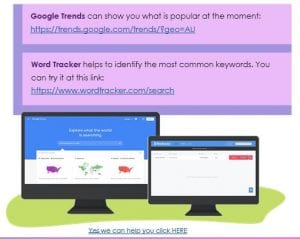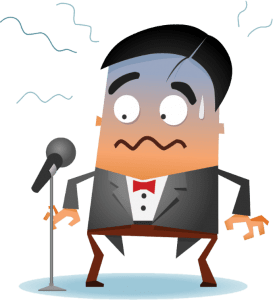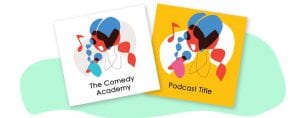10. What is the best format for a podcast?
While some do broadcast live to air, let’s assume for our purposes that you will first start by prerecording and possibly editing the podcast before putting it to air.
The format you choose to go with will be your personal choice, and when deciding on a format, the starting point is to ask yourself Who is to be involved.
Will it just be you? Or are you intending to have one or more co-hosts? Will you be interviewing guests, or perhaps playing excerpts of prerecorded interviews or material? If having more than one participant or host, will an online connection between more than one location be required?
The Solo Show – Monologue Format
If it’s just you, then in many ways a solo show is much simpler. It will basically consist of a monologue – with or without inserted, prerecorded pieces. In a solo show you can build your credibility and authority on the subject matter without having to rely on others to help present the material in each episode.
While it is more straightforward, the solo show is probably also the most
intimidating format for a newbie podcaster. People have observed that one of the biggest challenges they found in going solo is getting over the feeling that they are just “talking to themself” and realising rather, that they’re talking to the “listener”.
This is where it is helpful to remember the profile or persona that you came up with earlier, for the typical listener in your target audience. During the podcast, imagine you are conversing with them. Take the opportunity to answer the kinds of questions that people tend to ask you about your topic and maybe give them something new and interesting to learn from you. Think back to the keywords and topics you decided were useful in the earlier stages and refer to them in the things you say.
Yes we can help you click HERE
The Co-Hosted Show Format – Presenting alongside a friend or colleague.
For many, it’s easier and personally less pressured a format to chat on the show with someone else. With the right co-host you can have interesting two-way dialogue: bouncing off each other’s ideas, debating, or even laughing and joking with each other. Good, co-hosted podcasts often have some great chemistry going on between the presenters. This can make for an exciting listening experience.
The challenge is scheduling both of you to be available to record together – whether in the same studio space, or via a live link. The advantage of a co-hosted format is that the two-way flow of communication can voice some of the questions or queries that target audience members may be wanting to know about, making it a more comfortable, ‘real’ vehicle for delivery of the information.
The Interview Show Format
In an interview show you will either be the interviewer, or the interviewee.
As the interviewee – If you are to be the ‘expert’ on your chosen subject, then someone else can ask you all the right questions, allowing you to respond with the material you want to get across. The dynamics of a two-way flow of interaction, similarly to the co-hosted format discussed above, help what you say to come across in a more relaxed, conversational way.
As the interviewer – This is where you can present material of interest to your target audience by interviewing people who can bring your chosen subject matter to life. You could, for example, interview one or more of your heroes. Maybe you’d like the opportunity to chat with people you’ve always admired or looked up to, or with respected experts on relevant subjects. As interviewer you can shape the flow of what is presented in the podcast. Again, when asking questions, remember to put yourself in the shoes of your target audience ‘persona’ to elicit responses you think they’d like or need to know about. Interviewing and listening well are skills that you’ll need to hone through practice, practice, practice.
As an added bonus, your guests will sometimes have their own followers and audiences, who may access your podcast to hear the interview and they may end up subscribing to your show. If done right, you can really grow an audience in this way. By choosing the right guests you can expose your podcast to a much wider audience than it might otherwise achieve on its own – especially when you’re just starting out, so that is a point worth noting.















 The bare minimum of equipment you’ll need to record a podcast is a laptop with a built-in microphone and access to the internet. However, the more limited and low-cost your setup and equipment are, the lower the sound quality of your show.
The bare minimum of equipment you’ll need to record a podcast is a laptop with a built-in microphone and access to the internet. However, the more limited and low-cost your setup and equipment are, the lower the sound quality of your show.


 We’ll keep this part short and simple! Perhaps the easiest way to edit recorded calls is to use the Audacity program. It’s free and once you get the hang of it, the software just works.
We’ll keep this part short and simple! Perhaps the easiest way to edit recorded calls is to use the Audacity program. It’s free and once you get the hang of it, the software just works.
 The cover art you use for your podcast will be one of the things that attracts people to click and listen or to just scroll by. Because the artwork is often viewed in a smaller format, it doesn’t serve you well to clutter up the space with a lot of details that are hard to read. Often a simple photo of yourself, coupled with your logo works well. It is unique and shows you are a real person that listeners can engage with. Another alternative is a picture that relates to your subject matter or theme, with your name or logo.
The cover art you use for your podcast will be one of the things that attracts people to click and listen or to just scroll by. Because the artwork is often viewed in a smaller format, it doesn’t serve you well to clutter up the space with a lot of details that are hard to read. Often a simple photo of yourself, coupled with your logo works well. It is unique and shows you are a real person that listeners can engage with. Another alternative is a picture that relates to your subject matter or theme, with your name or logo.
